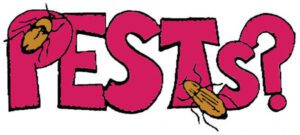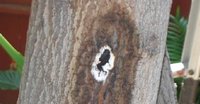
February 12, 2013
Dear Urban Forestry Friends,
This issue of the California Urban Forests Newsletter is all about pests–from beetles to fungus; many of our trees are at risk, but there are steps we can take to protect our trees:

- Two invasive pests found in Riverside County
- Lessons learned and steps to take: spread the word to stop the spread: “DON’T MOVE FIREWOOD”
- More pest resources
Thank you for all you do for urban forestry!
Regards,

Sonali Shah
Communications Manager
California Urban Forests Council
Hello Urban Forests Friends,
This issue of the CaUFC newsletter is dedicate to birds, one of the biggest dependents and supporters of trees. Birds and trees have a symbiotic relationship and as humans we gain from both these natural wonders. So, in honor of trees & birds read on:
Thanks for all you do for urban forestry for us and for the birds!

Study finds: Urban Trees Promote Bird Diversity
A study by Australian National University PhD candidate Karen Stagoll found that large trees in urban parks are “keystone structures” which provide important habitat and contribute to the richness, abundance and breeding of birds.

The report warns that “the loss of large trees from urban settings may have far-reaching ecological consequences”.
But if you want to save native birds we need native needs. A study in Australia found the amount of native trees on suburban streets has a big effect on the numbers and types of birds in the area.
Urban Trees help Migrating Birds
Besides all the benefits that trees provide to humans, they also help wildlife including bird conservation.
Beautiful Bird Ballet
A 2010 study showed that: “Within migration, land birds spend up to 90% of their time resting and regaining energy at stopover sites, making habitat a key component,” they explained. Read more here.
Trees bring birds to our backyards
 Did you know: 60 million people spend close to a billion dollars annually on birdseed and associated products hoping to attract melodic tunes to their yards. However, trees are the main attraction for our feathered friends as it provides them with the necessities– food, water, and shelter.
Did you know: 60 million people spend close to a billion dollars annually on birdseed and associated products hoping to attract melodic tunes to their yards. However, trees are the main attraction for our feathered friends as it provides them with the necessities– food, water, and shelter.
Here’s a list by the National Gardening Association on trees and plants that are good for attracting birds to the urban garden:
Can you guess the three most common city birds?
The three most common city birds are the starling, sparrow and pigeon. They are three very adaptable species, always ready to exploit a potential food source or a suitable nest site.
 Starling: Sturnus vulgaris
Starling: Sturnus vulgaris
Starlings are sociable birds – they congregate in the thousands and fly to suitable roosts.
Read more here
 House Sparrow: Passer domesticus
House Sparrow: Passer domesticus
The House sparrow, found in all towns and cities, was first attracted to urban areas back when the only form of transport was horse-drawn. Read more here
 Town or Feral Pigeon: Columba livia
Town or Feral Pigeon: Columba livia
The common town pigeons we see around us every day have descended from the wild Rock dove found around the coasts, but the city birds were descended from domestic pigeons which escaped from medieval dovecotes. Read more here
|
||||
|
Partners in Crime: The Polyphagous Shot Hole Borer & fungus Fusarium sp.

The Polyphagous Shot Hole Borer and fungus Fusarium sp. is especially harmful to avocado trees. However, the beetle has a number of other hosts, including the box elder, black locust, bigleaf maple, and more.
Click here for tips on what to look for, including single exit hole with surrounding white powdery exudates, and who to contact if you find the problem.
Immediate steps to help stop the spread of pests
“DON’T MOVE FIREWOOD”:
- Use firewood from local sources – “Buy it Where you Burn It”
- Leave firewood at home – do not transport it to recreational cabins,
campgrounds or parks - Anyone planning to purchase or burn firewood is encouraged to visit www.firewood.ca.gov to learn how help stop the spread of GSOB and other pests through the movement of firewood.
- Share with your network
More Resources:
Trees, Pests, and People film by Dontmovefirewood.org
Is the story of three kinds of trees: Walnut, Avocado, and Ash, all threatened by invasive insects and diseases—forest pests. This is the story of how these pests affect people’s everyday lives and how we can all help to protect our trees and forests. Click here to go to the site.

Imapinvasives
Facilitates the management and sharing of invasive species information, including the extent of infestations, search efforts, and treatment outcomes. Affordable, sustainable, and collaborative tools developed by the Partnership provide a flexible platform for aggregating invasive species data from a wide variety of sources. Click here to go to the site.
Report A Pest by the California Dept of Food & Ag
Provides tips and information on how to report a New or Unusual Plant or Pest in your area. Click here to go to the site.
Continental Dialogue
Cultivates collaborative action among diverse interests to abate the threat to North American forests from non-native insects and diseases. Click here to go to the site.
Here’s a V-Day dinner and a movie idea:
Lurking in the Trees, the Movie

Lurking in the Trees film Dontmovefirewood.org
When a foreign invasive pest – the Asian longhorned beetle – was discovered to be killing Worcester’s MA maple trees, the city took decisive action to halt the spread of the beetle, protecting trees across New England from certain death. Click here to go to the site.


 2627 likes
2627 likes

